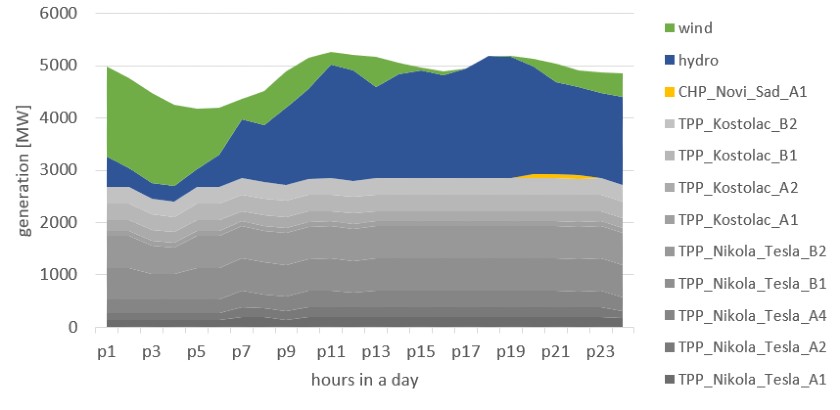
Photo: Nenad Jovanović
Author: Nenad Jovanović, PhD in electrical engineering
This case study shows that there is enough technical flexibility of existing generators in the Serbian power system to maintain load balance and provide balancing reserves for intermittent renewable energy sources (RES) in the amount of 1,865 MW, which is five times more than the currently installed capacity of 373 MW. This means that this increased installed wind farm capacity can be maintained even without the announced construction of the pumped storage hydropower (PSH) plant Bistrica.
In order to ensure a safe supply of electricity, it is necessary to plan the optimal operation of the power system and manage many activities in real time. Among the big number of activities, the public is mostly curious about balancing and whether the Serbian power system can deal with additional intermittent renewable energy capacities such as generation from wind farms.
In this regard, at the beginning of 2021, I wrote the paper Unit Commitment and Balancing Reserve Needs with Intermittent RES – Serbian Power System Case Study, which aims to explain how the power system in Serbia operates and which power plants would provide balancing of 1.865 MW of wind power capacity, compared to current 373 MW that is connected to the transmission system network. The paper was presented at the 37th International Conference Energetika 2022 in June 2022, and officially published in the journal Energija, ekonomija, ekologija on the 15h of December 2022.
Before we move on to the methodology and results of the study, we need to clarify what is load balancing and what are balancing reserves.
Let’s assume that the entire power system of Serbia is one reservoir of water in which there are constant inflows and outflows, whereby the water level must always remain the same. It is obvious that the water level in the reservoir will increase in case of an unplanned increase in water inflow with an unchanged outflow. For the reservoir to always remain at the same level, additional auxiliary services need to be provided.
In the case of the power system, the generation and consumption of electricity (load balancing) are the equivalents of inflows and outflows from the previous example, while a frequency of 50 Hz at which the power system operation is stable (balancing reserve) is the level of the reservoir.
Load balance and balancing reserves are two inseparable and different activities
Load balancing is related to satisfying the need for electricity consumption. At any moment, a sufficient set of generators should be committed in order to equalise generation with consumption. These two magnitudes cannot be completely the same because they constantly change, so sometimes generation will rise and the system will work with a frequency higher than 50 Hz, and vice versa. For this reason, the power system needs auxiliary activities related to frequency regulation – the well-known balancing reserves.
Balancing reserves are related to providing sufficient reserves of power and energy in order to equalise the level of generation and consumption. The reasons for the uneven level of these two magnitudes, or imbalance, are related to factors such as changes in dispatching of committed generators or the consumption forecasts or wind farm generation.
The balance reserve consists of online and offline power plants that have the ability to change their generation output upon request. According to the time of activation and the amount of power, the balance reserve can be classified as primary, with the fastest activation; secondary, which has an activation time of up to 15 minutes; and tertiary, which replaces the secondary one 30 minutes after the imbalance has occurred in the system. We will focus on secondary and tertiary reserves.
the balance reserve can be classified as primary, with the fastest activation; secondary, which has an activation time up to 15 minutes; and tertiary, which replaces the secondary after 30 minutes from the moment of occurred imbalance in the system.
Brief explanation of the Serbian power system case study
In the paper, a mathematical model was developed that optimises the dispatching of 62 generators from 21 power plants owned by Elektroprivreda Srbije (EPS) in a period of 24 hours. Unlike commercial models, which are mainly used by transmission system operators for dispatching planning, the developed model uses the wind power generation and consumption profile as input data, and hydropower plant generation (HPP) comes as a result of optimisation.
Modelling of HPP operation is of utmost importance for Serbia’s power system because these power plants are mostly used for balancing reserves due to their flexibility and up/down rump rates.
As a reference example, the 29th of January 2022 is used. Wind farm generation was the highest during the morning hours and they stopped for a moment in the afternoon hours. If the wind farm generation forecast deviates a lot from the actual generation, the system can be brought into unstable operation. In addition to this characteristic, the entire case is additionally interesting to analyse the system operation as it was Saturday, a day in a week when consumption is lower, and it was winter, so some less flexible thermal power plants (TPPs) operated in a must-run mode to provide heat for district heating systems.
This case becomes more complex if wind farm penetration is five times higher. For the sake of model calibration proof, the obtained generation profile of all HPPs (chart in grey) is compared with the real generation, obtained from the Energy Flux website on the 29th of January (chart in blue).

Which power plants can provide a balancing reserve if the share of RES is high
The current balance reserve, which includes secondary and tertiary reserves, is dimensioned at 380 MW for Serbia’s power system, within the control block of Serbia, Montenegro and North Macedonia. A maximum value of 631 MW was considered to be available for this case study with a high share of RES.
The following power plants can operate in the secondary reserve: HPP Đerdap 1, HPP Bistrica, HPP Bajina Bašta, PSH plant Bajina Bašta and four units of TPP Nikola Tesla (A3-A6). The need for tertiary reserves can be provided by all the power plants in the system, both the ones that are online and the ones that are turned off. The operation of the transmission network is assumed to be optimal, which means that the country’s transmission system operator Elektromreža Srbije (EMS) is carrying out all necessary interventions on the transmission network to connect additional wind farm capacity.
Wind farms would have a significant impact on the morning dispatching of generators
The generation profile for wind farms with a total capacity of 1.865 MW has a significant impact on the traditional generators dispatching in the morning, when consumption decreases. At that moment, most HPP generators are turned off or they produce at a significantly low level, and TPPs generate close to their technical minimum.
The following chart shows the result of system load balancing during 24 hours with a potentially high share of renewable energy sources, which is based on the example of electricity consumption in Serbia on the 29th of January 2022. As can be seen in the chart, the dispatching of all active TPP generators is indicated with a spectrum of shades of grey, HPPs are blue and wind farms are marked green.

In addition to the necessary load balance, recommending generators that can meet the proposed amount of balancing reserves is another result of the model. Necessary secondary balance reserves are provided by HPP Đerdap 1 and HPP Bajina Bašta, for upward and downward directions. Also, the tertiary upward reserve is mainly covered by hydropower plants.
However, for the needs of tertiary downward reserves during the morning hours, HPPs are not sufficient to cover the downward direction because their generation is squeezed. Therefore, additional available power from generators TPP Nikola Tesla B2 and TPP Kostolac A1-A2 and B1-B2 is reserved for the first few hours of the day. The other four TPP generators operated close to their technical minimum in the morning hours and cannot provide system balancing services by further reducing electricity generation.
It is interesting to point out that in this example the system can provide balancing reserves without the existing PSH plant Bajina Bašta, which can play an important role in preserving the stability of the system. Also, in the third period (marked as p3 in the chart), the share of wind farms reached as much as 38.54% of total electricity generation.


















Very reasoned and relevant to overcome barriers (more often artificial ones) created by existing energy operators.Thanks to the author.